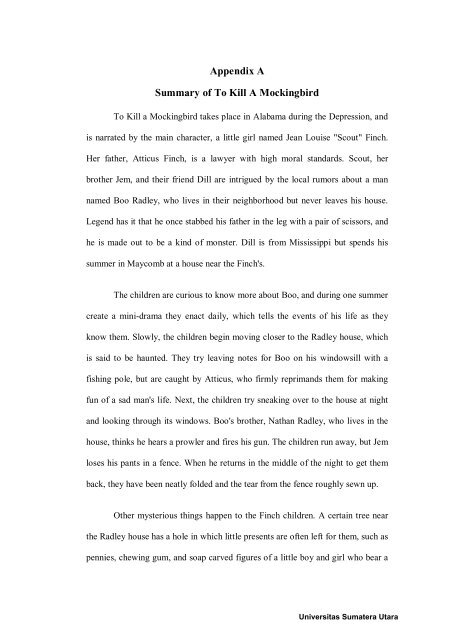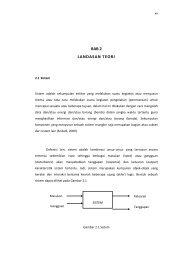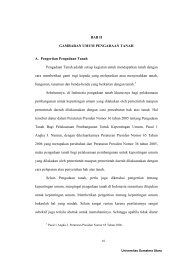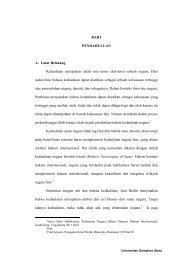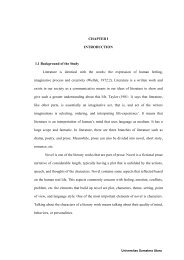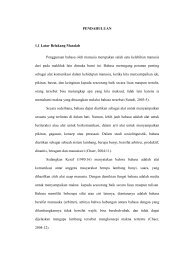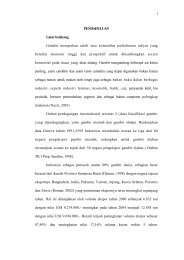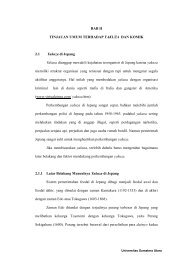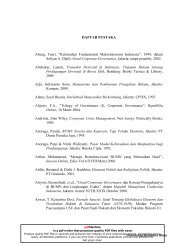Appendix A Summary of To Kill A Mockingbird - USU Institutional ...
Appendix A Summary of To Kill A Mockingbird - USU Institutional ...
Appendix A Summary of To Kill A Mockingbird - USU Institutional ...
Create successful ePaper yourself
Turn your PDF publications into a flip-book with our unique Google optimized e-Paper software.
<strong>Appendix</strong> A<br />
<strong>Summary</strong> <strong>of</strong> <strong>To</strong> <strong>Kill</strong> A <strong>Mockingbird</strong><br />
<strong>To</strong> <strong>Kill</strong> a <strong>Mockingbird</strong> takes place in Alabama during the Depression, and<br />
is narrated by the main character, a little girl named Jean Louise "Scout" Finch.<br />
Her father, Atticus Finch, is a lawyer with high moral standards. Scout, her<br />
brother Jem, and their friend Dill are intrigued by the local rumors about a man<br />
named Boo Radley, who lives in their neighborhood but never leaves his house.<br />
Legend has it that he once stabbed his father in the leg with a pair <strong>of</strong> scissors, and<br />
he is made out to be a kind <strong>of</strong> monster. Dill is from Mississippi but spends his<br />
summer in Maycomb at a house near the Finch's.<br />
The children are curious to know more about Boo, and during one summer<br />
create a mini-drama they enact daily, which tells the events <strong>of</strong> his life as they<br />
know them. Slowly, the children begin moving closer to the Radley house, which<br />
is said to be haunted. They try leaving notes for Boo on his windowsill with a<br />
fishing pole, but are caught by Atticus, who firmly reprimands them for making<br />
fun <strong>of</strong> a sad man's life. Next, the children try sneaking over to the house at night<br />
and looking through its windows. Boo's brother, Nathan Radley, who lives in the<br />
house, thinks he hears a prowler and fires his gun. The children run away, but Jem<br />
loses his pants in a fence. When he returns in the middle <strong>of</strong> the night to get them<br />
back, they have been neatly folded and the tear from the fence roughly sewn up.<br />
Other mysterious things happen to the Finch children. A certain tree near<br />
the Radley house has a hole in which little presents are <strong>of</strong>ten left for them, such as<br />
pennies, chewing gum, and soap carved figures <strong>of</strong> a little boy and girl who bear a<br />
Universitas Sumatera Utara
striking resemblance to Scout and Jem. The children don't know where these gifts<br />
are coming from, and when they go to leave a note for the mystery giver, they find<br />
that Boo's brother has plugged up the hole with cement. The next winter brings<br />
unexpected cold and snow, and Miss Maudie's house catches on fire. While Jem<br />
and Scout, shivering, watch the blaze from near the Radley house, someone puts a<br />
blanket around Scout without her realizing it. Not until she returns home and<br />
Atticus asks her where the blanket came from does she realize that Boo Radley<br />
must have put it around her while she was entranced by watching Miss Maudie,<br />
her favorite neighbor, and her burning house.<br />
Atticus decides to take on a case involving a black man named <strong>To</strong>m<br />
Robinson who has been accused <strong>of</strong> raping a very poor white girl named Mayella<br />
Ewell, a member <strong>of</strong> the notorious Ewell family, who belong to the layer <strong>of</strong><br />
Maycomb society that people refer to as "trash." The Finch family faces harsh<br />
criticism in the heavily racist Maycomb because <strong>of</strong> Atticus's decision to defend<br />
<strong>To</strong>m. But, Atticus insists on going through with the case because his conscience<br />
could not let him do otherwise. He knows <strong>To</strong>m is innocent, and also that he has<br />
almost no chance at being acquitted, because the white jury will never believe a<br />
black man over a white woman. Despite this, Atticus wants to reveal the truth to<br />
his fellow townspeople, expose their bigotry, and encourage them to imagine the<br />
possibility <strong>of</strong> racial equality.<br />
Because Atticus is defending a black man, Scout and Jem find themselves<br />
whispered at and taunted, and have trouble keeping their tempers. At a family<br />
Christmas gathering, Scout beats up her cloying relative Francis when he accuses<br />
Universitas Sumatera Utara
Atticus <strong>of</strong> ruining the family name by being a "nigger-lover". Jem cuts <strong>of</strong>f the tops<br />
<strong>of</strong> an old neighbor's flower bushes after she derides Atticus, and as punishment,<br />
has to read out loud to her every day. Jem does not realize until after she dies that<br />
he is helping her break her morphine addiction. When revealing this to Jem and<br />
Scout, Atticus holds this old woman up as an example <strong>of</strong> true courage: the will to<br />
keep fighting even when you know you can't win.<br />
The time for the trial draws closer, and Atticus's sister Alexandra comes to<br />
stay with the family. She is proper and old-fashioned and wants to shape Scout<br />
into the model <strong>of</strong> the Southern feminine ideal, much to Scout's resentment. Dill<br />
runs away from his home, where his mother and new father don't seem interested<br />
in him, and stays in Maycomb for the summer <strong>of</strong> <strong>To</strong>m's trial. The night before the<br />
trial, <strong>To</strong>m is moved into the county jail, and Atticus, fearing a possible lynching,<br />
stands guard outside the jail door all night. Jem is concerned about him, and the<br />
three children sneak into town to find him. A group <strong>of</strong> men arrive ready to cause<br />
some violence to <strong>To</strong>m, and threaten Atticus in the process. At first Jem, Scout and<br />
Dill stand aside, but when she senses true danger, Scout runs out and begins to<br />
speak to one <strong>of</strong> the men, the father <strong>of</strong> one <strong>of</strong> her classmates in school. Her<br />
innocence brings the crowd out <strong>of</strong> their mob mentality, and they leave.<br />
The trial pits the evidence <strong>of</strong> the white Ewell family against <strong>To</strong>m's<br />
evidence. According to the Ewells, Mayella asked <strong>To</strong>m to do some work for her<br />
while her father was out, and <strong>To</strong>m came into their house and forcibly beat and<br />
raped Mayella until her father appeared and scared him away. <strong>To</strong>m's version is<br />
that Mayella invited him inside, then threw her arms around him and began to kiss<br />
Universitas Sumatera Utara
him. <strong>To</strong>m tried to push her away. When Bob Ewell arrived, he flew into a rage<br />
and beat her, while <strong>To</strong>m ran away in fright. According to the sheriff's testimony,<br />
Mayella's bruises were on the right side <strong>of</strong> her face, which means she was most<br />
likely punched with a left hand. <strong>To</strong>m Robinson's left arm is useless due to an old<br />
accident, whereas Mr. Ewell leads with his left. Given the evidence <strong>of</strong> reasonable<br />
doubt, <strong>To</strong>m should go free, but after hours <strong>of</strong> deliberation, the jury pronounces<br />
him guilty. Scout, Jem and Dill sneak into the courthouse to see the trial and sit in<br />
the balcony with Maycomb's black population. They are stunned at the verdict<br />
because to them, the evidence was so clearly in <strong>To</strong>m's favor.<br />
Though the verdict is unfortunate, Atticus feels some satisfaction that the<br />
jury took so long deciding. Usually, the decision would be made in minutes,<br />
because a black man's word would not be trusted. Atticus is hoping for an appeal,<br />
but unfortunately <strong>To</strong>m tries to escape from his prison and is shot to death in the<br />
process. Jem has trouble handling the results <strong>of</strong> the trial, feeling that his trust in<br />
the goodness and rationality <strong>of</strong> humanity has been betrayed.<br />
Meanwhile, Mr. Ewell threatens Atticus and other people connected with<br />
the trial because he feels he was humiliated. He gets his revenge one night while<br />
Jem and Scout are walking home from the Halloween play at their school. He<br />
follows them home in the dark, then runs at them and attempts to kill them with a<br />
large kitchen knife. Jem breaks his arm, and Scout, who is wearing a confining<br />
ham shaped wire costume and cannot see what is going on, is helpless throughout<br />
the attack. The elusive Boo Radley stabs Mr. Ewell and saves the children.<br />
Finally, Scout has a chance to meet the shy and nervous Boo. At the end <strong>of</strong> this<br />
Universitas Sumatera Utara
fateful night, the sheriff declares that Mr. Ewell fell on his own knife so Boo, the<br />
hero <strong>of</strong> the situation, won't have to be tried for murder. Scout walks Boo home<br />
and imagines how he has viewed the town and observed her, Jem and Dill over<br />
the years from inside his home. Boo goes inside, closes the door, and she never<br />
sees him again.<br />
Universitas Sumatera Utara
<strong>Appendix</strong> B<br />
Characters List<br />
Scout (Jean Louise) Finch: Scout is the main character, or protagonist. As an<br />
adult first-person narrator, she tells the story <strong>of</strong> her childhood experiences,<br />
beginning just before her sixth birthday. Scout is intelligent, curious, outspoken,<br />
and feisty. A tomboy, she prefers pants to dresses, beats up boys, and grows up<br />
playing the same games as her constant male companions—her brother, Jem, and<br />
her neighbor's nephew, Dill. Scout also loves books and is an avid reader even<br />
before she enters first grade..<br />
Atticus Finch: Scout's father, a widower. He is a compassionate, fair-minded,<br />
self-educated attorney who takes the time to instill moral values and common<br />
sense in Scout and her brother. One <strong>of</strong> the most important lessons he teaches them<br />
is that they must learn to walk in the shoes <strong>of</strong> other people before attempting to<br />
criticize or analyze them. At times, he tells them, it may be necessary to bend the<br />
law to accommodate individual differences in people. He incurs the wrath <strong>of</strong> the<br />
community after he decides to defend a Negro, <strong>To</strong>m Robinson, who is accused <strong>of</strong><br />
raping a white girl. His <strong>of</strong>fice is in the Maycomb Bank building. Except for his<br />
defense <strong>of</strong> <strong>To</strong>m Robinson, Finch plays no active role (other than setting a good<br />
example) in activities to improve the lot <strong>of</strong> blacks.<br />
Jeremy Atticus (Jem) Finch: Scout's brother, who is four years older than she.<br />
Like Scout, he is intelligent and curious. Though congenial and understanding, he<br />
can be a fierce defender <strong>of</strong> his family's honor. He helps in Scout's maturation by<br />
passing along to her advice and insights he has received from Atticus and others.<br />
After the jury finds <strong>To</strong>m Robinson guilty <strong>of</strong> rape, Jem experiences deep<br />
disillusionment in society's fair-mindedness and becomes moody and irritable for<br />
a time.<br />
Charles Baker (Dill) Harris: Nephew <strong>of</strong> the Finch family's next-door neighbor<br />
Rachel Haverford. During his summer vacations in Maycomb, he becomes good<br />
friends with Scout and Jeremy and a partner in their childhood adventures. Harper<br />
Lee modeled him after her childhood friend, author Truman Capote. Dill<br />
exaggerates the accomplishments <strong>of</strong> his family and sometimes tells outright lies in<br />
order bolster his self-esteem and ingratiate himself with Scout and Jem. He is<br />
especially curious about the mysterious and reclusive Boo Radley and concocts<br />
several schemes to get Boo to come out <strong>of</strong> his house and show himself.<br />
Calpurnia: Loyal and level-headed Negro cook for Atticus Finch. In addition to<br />
Universitas Sumatera Utara
her kitchen duties, Calpurnia watches over Scout and Jem and scolds Scout for<br />
improper behavior whenever necessary. She is a few years older than Atticus.<br />
Alexandra Finch Hancock: Sister <strong>of</strong> Atticus. She comes to Maycomb to live<br />
with him to help tomboy Scout learn ladylike behavior. Her gentility and<br />
knowledge <strong>of</strong> the social graces endears her with Maycomb society, but Scout<br />
regards her as a pain in the neck.<br />
Jimmy Hancock: Husband <strong>of</strong> Alexandra.<br />
Dr. John Hale (Jack) Finch: Younger brother <strong>of</strong> Atticus and uncle <strong>of</strong> Scout.<br />
Atticus helped put him through medical school. Scout looks up to him because <strong>of</strong><br />
his genial manner and willingness to listen to her views, although he doesn't<br />
hesitate to correct her when he sees the need.<br />
Arthur (Boo) Radley: Maycomb man who remains inside his home, just down<br />
the street from the Finch residence. When he was about sixteen, he made friends<br />
with a rowdy group and repeatedly got into trouble. One night, police arrested the<br />
whole gang <strong>of</strong> them for causing a ruckus. Boo was locked in the courthouse<br />
basement for a considerable time. Eventually, he was released into his father's<br />
custody and remained confined to the Radley home for seventeen years. One day,<br />
he became the subject <strong>of</strong> town talk after he stabbed his father in the leg with<br />
scissors, inflicting a deep wound. When Scout and Jem are growing up, townfolk<br />
tell stories about him that strike fear into everyone's heart.<br />
Mr. Radley: Boo's father, whom Calpurnia regards as the meanest man in town.<br />
According to Maudie Atkinson, he is a very strict Baptist who regards any form <strong>of</strong><br />
pleasure a sin.<br />
Mrs. Radley: Mr. Radley's wife. Although she does not mingle with others in the<br />
community, she occasionally goes outside to water her flowers.<br />
<strong>To</strong>m Robinson: Twenty-five-year-old Negro wrongfully accused <strong>of</strong> raping a<br />
white woman. At his trial, Atticus defends him with arguments making plain that<br />
he could not have committed the crime. However, a jury <strong>of</strong> white males finds him<br />
guilty. Later, when he attempts to escape, he is shot and killed.<br />
Miss Caroline Fisher: Scout's inexperienced first-grade teacher.<br />
Universitas Sumatera Utara
Robert E. Lee (Bob) Ewell: Cruel, spiteful, evil-minded head <strong>of</strong> the Ewell<br />
family. Because he spends most <strong>of</strong> his money on liquor, his family lives in<br />
squalor. When his daughter, Mayella, makes advances toward <strong>To</strong>m Robinson,<br />
Ewell witnesses her behavior, then beats her. He then tells the sheriff that<br />
Robinson raped her. At the trial, he testifies that "I seen that black nigger yonder<br />
ruttin' on my Mayella."<br />
Mayella Ewell: Bob Ewell's nineteen-year-old daughter. Because <strong>of</strong> her father's<br />
alcoholism, she virtually runs the Ewell household, looking after the children and<br />
doing the chores.<br />
Burris Ewell: Bob Ewell's son, a mean boy who calls Miss Fisher a "snot-nosed<br />
whore."<br />
Helen Robinson: Wife <strong>of</strong> <strong>To</strong>m Robinson and mother <strong>of</strong> three children. Bob Ewell<br />
harasses her after <strong>To</strong>m Robinson's trial.<br />
Miss Maudie Atkinson: Amiable neighbor <strong>of</strong> the Finch family who is about the<br />
same age as Atticus and shares his admirable moral values. She is a good friend <strong>of</strong><br />
Scout and Jem, treating them as her equals. She provides them information about<br />
Atticus in his younger days, before Scout and Jem were born. When her house<br />
burns down, she does not dwell on her misfortune but instead looks forward to<br />
building anew. Maudie likes to bake and saves tasty samples <strong>of</strong> her concoctions<br />
for Scout, Jem, and Dill. She also likes to garden, a practice that rigid Baptists tell<br />
her is sinful.<br />
Miss Rachel Haverford: Next-door neighbor <strong>of</strong> the Finch family with whom Dill<br />
Harris lives during the summer. Miss Haverford, the sister <strong>of</strong> Dill's mother, is a<br />
secret tippler, according to Dill.<br />
Miss Stephanie Crawford: Maycomb's town gossip. After fire burns Maudie<br />
Atkinson's house, Maudie stays with Stephanie.<br />
Mrs. Henry Lafayette Dubose: Old woman who lives two houses north <strong>of</strong> the<br />
Finches. Depicted by Scout as a malicious, ill-tempered hag, she sharply criticizes<br />
Scout and her brother when they walk past her house. After her death, Scout<br />
learns from Atticus that Mrs. Dubose suffered from a painful terminal disease<br />
requiring her to take morphine to gain relief. However, in her last days, she<br />
stopped taking the painkiller in order to die drug-free, with dignity. Atticus holds<br />
her up to Scout and Jem as an example <strong>of</strong> a courageous woman.<br />
Universitas Sumatera Utara
Heck Tate: Forty-three-year-old sheriff <strong>of</strong> Maycomb County.<br />
John Taylor: Elderly judge who asks Atticus to defend <strong>To</strong>m Robinson in an<br />
effort to give Robinson the best defense possible. Taylor presides at the<br />
Robinson's trial.<br />
Horace Gilmer: Prosecuting attorney in <strong>To</strong>m Robinson's trial.<br />
Braxton Bragg Underwood: Owner, editor, typesetter, and printer <strong>of</strong> the local<br />
newspaper, The Maycomb Tribune.<br />
Zeebo: Maycomb garbage collector and son <strong>of</strong> Calpurnia. He leads the singing <strong>of</strong><br />
hymns at Calpurnia's church. When Calpurnia brings Scout and Jem to Sunday<br />
services, he welcomes them.<br />
Dr. Reynolds: <strong>To</strong>wn doctor who attends Mr. Radley when he is dying. A good<br />
friend <strong>of</strong> the Finches, he delivered both Jem and Scout at birth. After Bob Ewell<br />
attacks Jem, Dr. Reynolds treats his injuries.<br />
Link Deas: <strong>To</strong>m Robinson's fair-minded boss at a Maycomb business. At the<br />
trial, he rises in the audience to tell everyone in the courtroom about the<br />
uprightness <strong>of</strong> <strong>To</strong>m's character. He later employs Helen Robinson in his business.<br />
When Bob Ewell harasses her, Deas scares him <strong>of</strong>f with a threat to have him<br />
arrested.<br />
Crazy Addie: Perpetrator <strong>of</strong> gruesome crimes—the mutilation <strong>of</strong> chickens and<br />
household pets—for which Boo Radley receives the blame. Crazy Addie later<br />
drowns himself.<br />
Sam Levy: Jewish resident <strong>of</strong> Maycomb in 1920. He is referred to as having<br />
shamed members <strong>of</strong> the Ku Klux Klan when they came to his house.<br />
Walter Cunningham: Head <strong>of</strong> a poor white family that refuses to accept charity.<br />
When Atticus does legal work for him, Cunningham pays with food.<br />
Young Walter Cunningham: Boy in Scout's first-grade class who brings no<br />
lunch to school because he cannot afford it. When his teacher, Miss Fisher, <strong>of</strong>fers<br />
Universitas Sumatera Utara
to lend him a quarter to buy lunch, he refuses it because he knows he cannot pay it<br />
back. In the school yard later, Jem invites him to lunch at the Finch home.<br />
Mrs. Grace Merriweather: Composer <strong>of</strong> the Halloween pageant who is<br />
prominent in social circles. As a member <strong>of</strong> the Missionary Society, she laments<br />
the living conditions <strong>of</strong> certain African people but snidely criticizes the blacks in<br />
her own community.<br />
Sophy: Mrs. Merriweather's cook.<br />
Agnes Boone: Student dressed as a butterbean for the Halloween pageant.<br />
Henry Hancock: Son <strong>of</strong> Jimmy and Alexandra Hancock.<br />
Francis Hancock: Son <strong>of</strong> Henry Hancock. Scout beats him up after he tells her<br />
that Atticus is a "nigger lover."<br />
Cecil Jacobs: Schoolchild who walks a mile out <strong>of</strong> his way each day to avoid<br />
passing in front <strong>of</strong> the Radley house and the Dubose house. He taunts Scout for<br />
Atticus's defense <strong>of</strong> a Negro.<br />
Chuck Little: Classmate <strong>of</strong> Scout who tries to calm Miss Fisher when a "cootie"<br />
(louse) from the hair <strong>of</strong> Burris Ewell frightens her.<br />
D. C.: First-grader in Scout's class.<br />
Miss Blount: Sixth-grade teacher who comes to the door <strong>of</strong> Miss Fisher's<br />
classroom to quiet the unruly children.<br />
Mr. Avery: Elderly man who boards in Miss Maudie Atkinson's house.<br />
Mr. Conner: Law <strong>of</strong>ficer at the time when Boo Radley was a teenager who<br />
befriended a group <strong>of</strong> rowdy boys. When Conner attempted to arrest them, they<br />
locked him the courthouse outhouse.<br />
Universitas Sumatera Utara
Dolphus Raymond: Wealthy Maycomb man who prefers the company <strong>of</strong> blacks<br />
to whites.<br />
Miss Spender: Fiancée <strong>of</strong> Dolphus Raymond. She killed herself after learning<br />
that he had a black mistress.<br />
Ruth Jones: Employee <strong>of</strong> the welfare <strong>of</strong>fice in Maycomb. After the WPA (Works<br />
Progress Administration) fires Bob Ewell, he tells her Atticus caused the loss <strong>of</strong><br />
his job. It is a lie. She informs Atticus <strong>of</strong> his accusation.<br />
Bert: Court reporter at the Robinson trial.<br />
Mrs. Taylor: Judge Taylor's wife.<br />
Jessie: Mrs. Dubose's maid.<br />
Ike Finch: Only surviving Confederate soldier in Maycomb County.<br />
Lily Brooke: Relation <strong>of</strong> Scout to whom Aunt Alexandra introduces her.<br />
Joshua S. St. Clair: Cousin <strong>of</strong> Scout who had written a book.<br />
Tensaw Jones: Spectator at the trial who voted the straight Prohibition ticket.<br />
Emily David: Spectator at the trial who uses snuff in private.<br />
Byron Waller: Spectator at the trial. He plays the violin.<br />
Jake Slade: Spectator at the trial.<br />
X. Billups: Spectator at the trial.<br />
Estelle: Hotel employee who sends food to Atticus to express her gratitude for his<br />
defense <strong>of</strong> <strong>To</strong>m Robinson.<br />
Universitas Sumatera Utara
Maxwell Green: Inexperienced attorney who would normally have been<br />
appointed by Judge Taylor to defend <strong>To</strong>m Robinson. However, Taylor, wanting to<br />
give Robinson every advantage possible, appoints the more experienced Atticus<br />
instead.<br />
Sarah and Frances Barber: Spinster sisters who are the only Maycomb residents<br />
with a cellar in their house. One Halloween, pranksters steal into their house while<br />
they are asleep and move all <strong>of</strong> their furniture into the cellar.<br />
Mrs. Crenshaw: Local seamstress who fashions Scout's ham costume for the<br />
Halloween pageant.<br />
Eunice Ann Simpson: Child whom Scout and her churchgoing companions tied<br />
to a chair in the furnace room <strong>of</strong> the church. During the sermon, she began<br />
banging on radiator pipes. When rescued, she declared that she no longer wanted<br />
to act the part <strong>of</strong> Shadrach (Daniel: Chapter 3, Verses 12-27).<br />
Gertrude Farrow: Member <strong>of</strong> the Maycomb Missionary Society.<br />
Universitas Sumatera Utara
<strong>Appendix</strong> C<br />
Biography <strong>of</strong> Harper Lee<br />
Nelle Harper Lee was born on April 28, 1926, in Monroeville, Alabama.<br />
Lee Harper is best known for writing the Pulitzer Prize-winning best-seller <strong>To</strong> <strong>Kill</strong><br />
a <strong>Mockingbird</strong> (1960)—her one and only novel. The youngest <strong>of</strong> four children,<br />
she grew up as a tomboy in a small town. Her father was a lawyer, a member <strong>of</strong><br />
the Alabama state legislature, and also owned part <strong>of</strong> the local newspaper. For<br />
most <strong>of</strong> Lee’s life, her mother suffered from mental illness, rarely leaving the<br />
house. It is believed that she may have had bipolar disorder.<br />
One <strong>of</strong> her closest childhood friends was another writer-to-be, Truman<br />
Capote (then known as Truman Persons). <strong>To</strong>ugher than many <strong>of</strong> the boys, Lee<br />
<strong>of</strong>ten stepped up to serve as Truman’s protector. Truman, who shared few<br />
interests with boys his age, was picked on for being a sissy and for the fancy<br />
clothes he wore. While the two friends were very different, they both shared in<br />
having difficult home lives. Truman was living with his mother’s relatives in town<br />
after largely being abandoned by his own parents.<br />
In high school, Lee developed an interest in English literature. After<br />
graduating in 1944, she went to the all-female Huntingdon College in<br />
Montgomery. Lee stood apart from the other students—she could have cared less<br />
about fashion, makeup, or dating. Instead, she focused on her studies and on her<br />
writing. Lee was a member <strong>of</strong> the literary honor society and the glee club.<br />
Transferring to the University <strong>of</strong> Alabama at Tuscaloosa, Lee was known<br />
for being a loner and an individualist. She did make a greater attempt at a social<br />
life there, joining a sorority for a while. Pursuing her interest in writing, Lee<br />
contributed to the school’s newspaper and its humor magazine, the Rammer<br />
Jammer. She eventually became the editor <strong>of</strong> the Rammer Jammer.<br />
In her junior year, Lee was accepted into the university’s law school,<br />
which allowed students to work on law degrees while still undergraduates. The<br />
demands <strong>of</strong> her law studies forced her to leave her post as editor <strong>of</strong> the Rammer<br />
Jammer. After her first year in the law program, Lee began expressing to her<br />
family that writing—not the law—was her true calling. She went to Oxford<br />
University in England that summer as an exchange student. Returning to her law<br />
studies that fall, Lee dropped out after the first semester. She soon moved to New<br />
York City to follow her dreams to become a writer.<br />
Universitas Sumatera Utara
In 1949, a 23-year-old Lee arrived in New York City. She struggled for<br />
several years, working as a ticket agent for Eastern Airlines and for the British<br />
Overseas Air Corp (BOAC). While in the city, Lee was reunited with old friend<br />
Truman Capote, one <strong>of</strong> the literary rising stars <strong>of</strong> the time. She also befriended<br />
Broadway composer and lyricist Michael Martin Brown and his wife Joy.<br />
In 1956, the Browns gave Lee an impressive Christmas present—to<br />
support her for a year so that she could write full time. She quit her job and<br />
devoted herself to her craft. The Browns also helped her find an agent, Maurice<br />
Crain. He, in turn, was able to get the publishing firm interested in her first novel,<br />
which was first titled Go Set a Watchman, then Atticus, and later <strong>To</strong> <strong>Kill</strong> a<br />
<strong>Mockingbird</strong>. Working with editor Tay Hoh<strong>of</strong>f, Lee finished the manuscript in<br />
1959.<br />
Later that year, Lee joined forces with old friend Truman Capote to assist<br />
him with an article he was writing for The New Yorker. Capote was writing about<br />
the impact <strong>of</strong> the murder <strong>of</strong> four members <strong>of</strong> the Clutter family on their small<br />
Kansas farming community. The two traveled to Kansas to interview<br />
townspeople, friends and family <strong>of</strong> the deceased, and the investigators working to<br />
solve the crime. Serving as his research assistant, Lee helped with the interviews,<br />
eventually winning over some <strong>of</strong> the locals with her easy-going, unpretentious<br />
manner. Truman, with his flamboyant personality and style, also had a hard time<br />
initially getting himself into his subjects’ good graces.<br />
During their time in Kansas, the Cutters’s suspected killers, Richard Hickock and<br />
Perry Smith, were caught in Las Vegas and brought back for questioning. Lee and<br />
Capote got a chance to interview the suspects not long after their arraignment in<br />
January 1960. Soon after, Lee and Capote returned to New York. She worked on<br />
the galleys for her forthcoming first novel while he started working on his article,<br />
which would evolve into the nonfiction masterpiece, In Cold Blood. The pair<br />
returned to Kansas in March for the murder trial. Later that spring, Lee gave<br />
Capote all <strong>of</strong> her notes on the crime, the victims, the killers, the local<br />
communities, and much more. Soon Lee was engrossed her literary success story.<br />
In July 1960, <strong>To</strong> <strong>Kill</strong> a <strong>Mockingbird</strong> was published and picked up by the Book-<strong>of</strong>the-Month<br />
Club and the Literary Guild. A condensed version <strong>of</strong> the<br />
story appeared in Reader’s Digest magazine. The work’s central character, a<br />
young girl nicknamed Scout, was not unlike Lee in her youth. In one <strong>of</strong> the book’s<br />
major plotlines, Scout and her brother Jem and their friend Dill explore their<br />
fascination with a mysterious and somewhat infamous neighborhood character<br />
named Boo Radley. But the work was more than a coming-<strong>of</strong>-age story, however.<br />
Another part <strong>of</strong> the novel reflected racial prejudices in the South. Their attorney<br />
father, Atticus Finch, tries to help a black man who has been charged with raping<br />
Universitas Sumatera Utara
a white woman to get a fair trial and to prevent him from being lynched by angry<br />
whites in a small town.<br />
The following year, <strong>To</strong> <strong>Kill</strong> a <strong>Mockingbird</strong> won the prestigious Pulitzer<br />
Prize and several other literary awards. Horton Foote wrote a screenplay based on<br />
the book and used the same title for the 1962 film adaptation. Lee visited the set<br />
during filming and did a lot <strong>of</strong> interviews to support the film. Earning eight<br />
Academy Award nominations, the movie version <strong>of</strong> <strong>To</strong> <strong>Kill</strong> a <strong>Mockingbird</strong> won<br />
four awards, including Best Actor for Gregory Peck’s portrayal <strong>of</strong> Atticus Finch.<br />
The character <strong>of</strong> Atticus is said to have been based on Lee’s father.<br />
By the mid-1960s, Lee was reportedly working on a second novel, but it<br />
was never published. Continuing to help Capote, Lee worked with him on and <strong>of</strong>f<br />
on In Cold Blood. She had been invited by Smith and Hickock to witness their<br />
execution in 1965, but she declined. When Capote’s book was finally published in<br />
1966, a rift developed between the two friends and collaborators. Capote<br />
dedicated to the book to Lee and his longtime lover Jack Dunphy, but he failed to<br />
acknowledge her contributions to the work. While Lee was very angry and hurt by<br />
this betrayal, she remained friends with Truman for the rest <strong>of</strong> his life.<br />
That same year, Lee had an operation on her hand to repair damage done<br />
by a bad burn. She also accepted a post on the National Council <strong>of</strong> the Arts at the<br />
request <strong>of</strong> President Lyndon B. Johnson. During the 1970s and 1980s, Lee largely<br />
retreated from public life.<br />
She spent some <strong>of</strong> her time on a nonfiction book project about an Alabama<br />
serial killer, which had the working title The Reverend. But the work was never<br />
published.<br />
Lee continues to live a quiet, private life in New York City and<br />
Monroeville. Active in her church and community, she usually avoids anything to<br />
do with her still popular novel.<br />
Universitas Sumatera Utara


